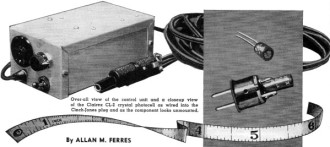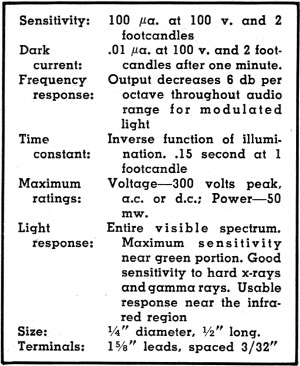|
Electronics hobbyists are always
anxious to hear the announcement of a new device that is forecast to revolutionize
the tech world. In the late 1950s something as relatively tame as a crystal photocell
satisfied that urge. This 1957 article in Radio & Television News magazine
is a prime example. Today it takes something like a negative refractive index metamaterial
to invoke the same sense of awe and wonder. Those were simpler times, but then again
even today's beginners in the world of electronics circuit designing and building
have to start somewhere, and these types of circuits are as good as any place.
Crystal Photocell Circuits
By Allan M. Ferres
The development of this tiny, light-sensitive cell makes possible an interesting
variety of compact control units.
The photoelectric cell is a most interesting subject for the electronic experimenter.
When connected to relays, the number of uses to which it can be put is limited only
by the ingenuity of the experimenter. It can be used for such diverse applications
as announcing a patient in a doctor's waiting room, turning on house lights and
advertising signs at dusk, automatically opening and closing doors, warning householders
of intruders, preventing shoplifting, etc. The list seems almost endless, but may
now be even further extended with the development of the crystal photocell.

Overall view of the control unit and a close-up view 01 the Clairex
CL-2 crystal photocell as wired into the Cinch-Jones plug and as the component looks
unmounted.
This tiny cell has several advantages over the high vacuum and gas-filled tubes
usually employed in photoelectric relay circuits. Its characteristics are such that
light-controlled relays may now be used in applications which are impractical with
the conventional photoelectric tubes.
The crystal photocell is a very small device about the size of a lead pencil
eraser, 1/4" in diameter and 1/2" long. The light sensitive element is a pure cadmium
sulphide crystal which responds to light over the entire visible spectrum. The crystal
is a semiconductor, its resistance decreasing with an increase in light intensity.
Its electrical characteristics are such that it may be operated at a considerable
distance from the associated amplifier and relay. This factor and its small size
make it ideal where concealment of the device is desirable, or where space is limited.
The crystal is so sensitive that operation is practical with normal room illumination
when used with a simple amplifier. This eliminates the necessity for using special
exciter lamps and optical equipment. In some applications, the relay may be operated
directly by the crystal itself. Its low cost and mechanical ruggedness make the
crystal photocell an ideal device for light-controlled relay experiments.
This article describes a control unit using a simple, basic photocell amplifier
and relay circuit. Four other circuits are also discussed which will be of interest
to experimenters.
The basic circuit, shown in Fig. 1A, is sensitive enough to operate at one-tenth
of a foot-candle of light. A protective resistor, R1, the crystal photocell,
the Clailrex CL-2, and the variable load resistor, R2, are connected
in series across the 117-volt a.c. line. C1, which shunts the load resistor,
charges to peak voltage on each cycle to provide a higher striking voltage for the
thyratron. The miniature thyratron, its current-limiting resistor, R3,
and the relay are also connected across the line through the switch S1.
The relay is a plate-circuit type having a coil resistance of 5000 to 8000 ohms
and an operating current of not more than 6 milliamperes and provided with s.p.d.t.
contacts. C2 shunts the relay coil to prevent chattering. The light,
bell, or other device to be operated plugs into receptacle SO1. As a
photocell relay is usually operated continuously, no a.c. "on-off" switch is included,
but, of course, one may be added if desired, in series with the line cord.

Fig. 1 - Five practical circuits using the Clairex CL-2
crystal photocell. (A) Basic circuit which will operate at 1/10th footcandle. (B)
Variation of basic circuit in which power is furnished to the output receptacle
when light falls on cell. (C) Circuit for operating lighting sequences. (D) Circuit
for high speed operation at low illumination levels. and (E) A simple setup to be
used as "intrusion" alarm.

Overall view of the photocell unit. It is built into a 2" x 3"
x 5" case. The placement of parts is non-critical as there is no heating. CL-2 unit
is at right.
The starter anode of the 5823 thyratron obtains its voltage from the voltage
divider made up of R1, the crystal cell, and R2. When the
cell is dark, its resistance is high and the starter anode voltage is too low to
allow the thyratron to draw plate current. When light strikes the cell, its resistance
drops, increasing the voltage across R2, and the tube conducts. With
the switch on, the relay contacts are wired so that the line voltage is connected
to the output receptacle only during the interval of time when the light on the
cell is interrupted. When the switch is off, a momentary interruption of the light
will remove the plate voltage from the thyratron and power will be furnished to
the receptacle continuously, even though the light to the cell is restored. This
locking type of operation is desirable when the device is used to sound an intruder
alarm bell.
As shown in the photographs, the necessary parts can be easily mounted in a 2"x
3" X 5" case. No ventilation of the case is needed as the power dissipated in the
unit is less than one watt. The placement of the parts is not at all critical, so
any convenient arrangement may be used. Socket terminals 2, 5, and 6 of the 5823
should not be used as tie points as these pins are used for internal connections
in the tube. The crystal photocell is wired into a Cinch-Jones type P-302-FHT plug.
A matching receptacle is mounted on the case, so that the cell can be either attached
to the case or used at a distance of 20 feet or so from it by means of an extension
cord.
Ordinary lamp cord is adequate for this purpose, provided that its insulation
is good, as leakage between the conductors will reduce the sensitivity and may cause
erratic operation. The cell can be shielded from stray illumination by a short length
of cambric tubing.
The unit is put into operation by turning switch S1 to "on," plugging
the line cord into an a.c. outlet, and pointing the photocell toward a source of
light. R2 is adjusted so that a steady blue glow appears in the thyratron
and the relay pulls in. Cutting off the light to the cell will cause the blue glow
in the tube to disappear and the relay will drop out. The adjustment of R2
is not critical, except with very low levels of illumination. Line voltage variations
will have little effect on the operation of the unit.
Fig. 1B is similar to the basic unit except that power is furnished to the
output receptacle when light falls on the cell, instead of when the cell is dark.
The switch must be set to "on" for locking operation. The only additional part required
is R4 a 1-megohm, 1-watt resistor which is wired to hold the tube in
conduction when the relay pulls in. This circuit might be used to open a gate or
garage door when the car's headlights illuminate the cell.
Fig. 1C is a good circuit to use to turn on signs or lights at dusk, and
to turn them off again at dawn. The cell load resistor is divided into two parts,
and an additional set of relay contacts is used to change the value of the load
when the relay drops out. This modification of the circuit is desirable to insure
positive operation of the relay at the time of day when the light is slowly fading
down to the operating value. R5 must be adjusted first so that the relay
pulls in, turning off the artificial light at the desired amount of daylight, and
then R6 is adjusted to turn on the light at dusk. The photocell must
be shielded from the artificial light, or the light will blink on and off in a form
of oscillation.

Fig. 2 - Average characteristics of the Clairex Type CL-2 crystal
photocell. See article.

Table 1 - Specifications on CL-2 photocell.
The circuit shown in Fig. 1D is useful when high speed operation is required
at very low illumination levels. The value of cathode capacitor, C4,
depends upon the amount of light available. For .1 footcandle, C4 should
be 100 µfd. and for 1 foot-candle, 10 µfd. is adequate. 150-volt capacitors
should be used. If fast recovery from an overload of light is necessary. R7
must be shunted by capacitor C3, its value being determined experimentally,
under actual operating conditions. The relay pulls in when the cell is exposed to
light and drops out when the cell is dark. The wiring of the output receptacle is
governed by the type of operation required. V2 may be either a 6C4 or
a12AT7 with the sections connected in parallel. Higher operating speed is obtained
with the 12AT7 The relay must be capable of fast operation to take full advantage
of this circuit. In some applications, a counter may be used in place of the relay.
A simple circuit which will sound a chime when someone enters a doorway is shown
in Fig. 1E. For the direct operation of the 1 milliampere relay, a light intensity
of 40 to 50 foot-candles is required. This can be conveniently obtained by placing
a 25-watt lamp on the same side of the doorway as the photocell and reflecting its
light into the cell with a magnifying mirror placed on the opposite door jamb. A
shaving mirror is suitable for this purpose. A small magnifying lens should be mounted
in front of the cell, focused to obtain maximum relay current. When the light on
the cell is interrupted by someone entering the doorway, the relay will drop out
and the chime, plugged into SO1 will sound.
Many other circuits and applications will occur to the experimenter as he works
with light-sensitive cells. The graph of Fig. 2 and Table 1 provide a useful
guide to the operating characteristics of the Clairex CL-2. When working out other
circuits, care should be taken not to exceed the 50-milliwatt power rating of the
cell as operation tends to become unstable above this point.
The service technician might well be able to add to his income by building and
installing light-operated equipment in stores, doctors' offices, machine shops,
etc. Building the basic unit described in this article, or one of the other circuits,
is a good way to get started toward designing commercially profitable devices. In
a more frivolous vein, they can be worked into some amusing parlor tricks.
The Clairex type CL-2 photocell is available from the Allied Radio Corporation,
100 North Western Avenue, Chicago 80, Illinois; Sun Radio and Electronics Company,
650 Avenue of the Americas, N. Y. 11, N. Y., and from the Clairex Corporation, 50
West 26th Street, New York 10, New York. The net price is $3.50.
The author wishes to thank Mr. Al Deuth of the Clairex Corporation for his cooperation
in providing data necessary to the preparation of this article.
Posted April 5, 2021
(updated from original post on 6/21/2013)
|
































